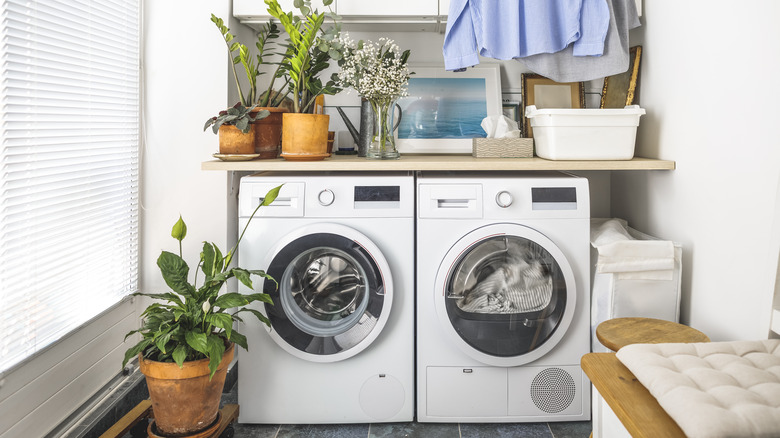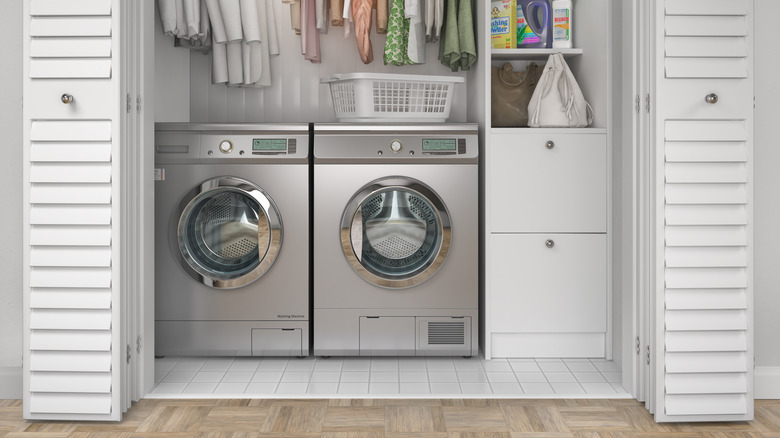Our Design Expert Names The Best Type Of Door For Your Laundry Room
In recent years, laundry rooms have moved from small, utilitarian spaces to Pinterest-worthy rooms with thoughtful details. They're no longer unfinished rooms that house everything from the furnace to unwanted storage. Because of this, most people now take the time to plan out every detail of the space, from paint colors to shelving options to door selections. The door you choose for the laundry room might seem insignificant, but a careful selection will increase the space's functionality. Because of this, we reached out to design expert Julie Jones, founder of Julie Jones Designs, to weigh in on what is the best type of laundry room door.
"This does depend on what type of laundry room it is," she exclusively told House Digest. A traditional laundry room that can accommodate a swinging door will have a different selection than, say, a closet laundry unit. "If it is a walk-in laundry room where a traditional door can be hung, make sure it is at least 30" wide, but 36" is better," she explains. This isn't just for aesthetic reasons—it helps make the task of washing clothes easier. "We often go in and out of laundry rooms carrying laundry baskets, and a larger opening would be more comfortable and convenient," Jones explains. But what if you have a smaller space? Take a look at which doors to consider below.
Try pocket doors for a cramped laundry room
The door can hamper your design if you're working with minimal square footage. For instance, an inward swinging door can block off a significant portion of the room and even come into contact with the appliances. An outward swinging door blocks traffic in the hallway, creating an equally awkward design. If this is your situation, Jones recommends a different type of door for your laundry room: a pocket door. "I have recommended pocket doors in some cases where the laundry room was too shallow to fit a door swing. Meaning a door swinging into the laundry room would either obstruct or hit the washer/dryer," she shares with House Digest. It's one of the best places in your home for a pocket door.
However, they usually cost more to install since a contractor needs to create the niche the doors will slide into. This can become even more expensive if the wall in question houses electrical or plumbing elements, which might need to be rerouted. On average, a pocket door installation costs $1,050, compared to $786 for a regular interior door. (This includes the cost of the door, materials, and professional labor.) If this is out of your budget, Jones suggests an alternative. "If a pocket door is not an option for structural or cost reasons, a barn door is the alternative to no door swing," she recommends.
A laundry closet should utilize bifold doors
What if you're working with an even smaller space, like a laundry closet? While pocket doors will make the space appear elegant, Jones recommends a more affordable alternative for the utilitarian nook. "If it is a laundry closet, bifold doors are best in my opinion," she tells House Digest. "This way they can give you full access to the washer and dryer and also not protrude into the space in front of the laundry units." To install bifold doors, with labor and materials, costs an average of $367, making it an affordable option for a laundry room design.
If you don't like the look of bifold doors, you don't have to choose the typical louvered options. If you have a more traditional home, you can choose wooden raised panel doors, such as the Kimberly Bay option that retails for $128 at Home Depot. It comes unfinished, which allows you to stain or paint it any color that you see fit. On the other hand, if you have a more industrial or contemporary aesthetic, then you can go with a six-panel frosted glass option, such as the RELIABILT option at Lowe's. However, since these doors don't have the ventilation that louvered doors offer, you need to keep them open while running the washer and dryer.

